Travel Through Cuba on a Harley-Davidson
By Peter & Kay Forwood
Cuba on a Harley (11/5/03 - 4/6/03)
Distance 2397 km (329150 km to 331547 km)
This is part of the ninth section of our around the
world trip.
Complete Trip Overview & Map
Coming from Jamaica
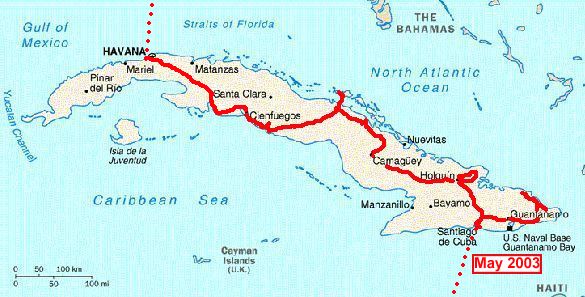 11/5/03 We started radioing the authorities at the 12 mile
limit but there was no response till only a few miles offshore when we were
advised to anchor in the bay. Santiago de Cuba has a magnificent harbour
entry to a country, an old castle on one headland and small boats ferrying
people across to islands and peninsulas, opening up into a large bay. Being
Sunday it took the authorities an hour to muster before we could come alongside
the marina, with quarantine the first 40 minutes and when cleared of diseases
a team of seven officials boarded. A few customs officials politely and efficiently
searched for over an hour, insisting that we watch to ensure no petty theft.
Agricultural inspectors checked food, looking for weevils mainly, and immigration
issued us with a tourist card ($US 15.00) valid for 30 days, using the boat
as our hotel booking, and yet we were free to leave the boat, travel independently,
and no onward ticket was asked for. We were now independent of the boat.
The motorcycle could be landed, and was, the tyres had to be washed in case
of diseases, and its import could be attached to our passports and not the
boat, thus also independent of the boat. Paperwork however for the motorcycle
would have to be done tomorrow, a working day. This whole process took till
2 pm, was polite, efficient and thorough. Drinks were offered, and accepted,
Coca Cola was not as favoured as the rum, where over a litre was consumed,
the officers leaving when the last of the bottle was consumed. The marina
manager offered us a welcome drink at the bar in the evening and we watched
dancing and partying at another pier out over the water. A great welcoming
and a relief to be able to move independently of the boat in Cuba.
11/5/03 We started radioing the authorities at the 12 mile
limit but there was no response till only a few miles offshore when we were
advised to anchor in the bay. Santiago de Cuba has a magnificent harbour
entry to a country, an old castle on one headland and small boats ferrying
people across to islands and peninsulas, opening up into a large bay. Being
Sunday it took the authorities an hour to muster before we could come alongside
the marina, with quarantine the first 40 minutes and when cleared of diseases
a team of seven officials boarded. A few customs officials politely and efficiently
searched for over an hour, insisting that we watch to ensure no petty theft.
Agricultural inspectors checked food, looking for weevils mainly, and immigration
issued us with a tourist card ($US 15.00) valid for 30 days, using the boat
as our hotel booking, and yet we were free to leave the boat, travel independently,
and no onward ticket was asked for. We were now independent of the boat.
The motorcycle could be landed, and was, the tyres had to be washed in case
of diseases, and its import could be attached to our passports and not the
boat, thus also independent of the boat. Paperwork however for the motorcycle
would have to be done tomorrow, a working day. This whole process took till
2 pm, was polite, efficient and thorough. Drinks were offered, and accepted,
Coca Cola was not as favoured as the rum, where over a litre was consumed,
the officers leaving when the last of the bottle was consumed. The marina
manager offered us a welcome drink at the bar in the evening and we watched
dancing and partying at another pier out over the water. A great welcoming
and a relief to be able to move independently of the boat in Cuba.
12/5/03 Authorities move politely, efficiently but slowly
with many forms and the need for accuracy as each piece of paper carries their
individually numbered seal. Customs at the marina gave us a form allowing
us to ride the motorcycle to customs in Santiago de Cuba. Customs in town
issued us with a 30 day temporary import ($US 10.00), extendable if
we extended our visa. The vehicle registration police however were unsure
how to proceed and after 3 hours waiting for a response from Havana we were
asked to return tomorrow. This was all interspersed as if riding through a
1950's movie set. The few cars on the road were either pre revolution American
models or post revolution Russian, both look pre 60's designs. Motorcycles
outnumber other vehicles, many with sidecars, again Russian copies of the
50's BMW's or Czechoslovakian MZ 250's. The vehicles are old but well maintained,
looking clean, painted, no oil leaks, but blow a lot of smoke. Old 50's Chevrolet
trucks carry goods in the city looking just 10 years old and horse drawn
wagons operate as local taxies, fruit sellers sell from the back of horse
drawn carts. The inner city shows little sign of any new building or renovation
with most places without paint or any obvious repair in years. We moved back
into the 21st century on the boat, to find the captain had been visited,
again, by customs, with a sniffer dog, taking a further two hours to search
the boat. A random search and finding nothing, they did however find a couple
of marijuana seeds on the Spanish boat next door, giving the captain a warning.
Drug related offences here carry severe penalties.
13/5/03 Two hours, the purchase of $US 30.00 worth of stamps
from the international bank, a vehicle inspection, a red and white tourist
number plate, and the bike was 100% legal in Cuba for the next 30 days. This
is the last new country of this trip. The motorcycle now having visited 143
countries, 75% of those in the world. By coincidence yesterday the odometer
recorded 100,000 km since the engine was rebuilt by Harley-Davidson of New
York using parts supplied by Morgan and Wacker of Australia. The engine hasn't
been opened in that time, however it now has two oil leaks, one serious,
not bad after visiting every country in North, Central and South America
plus the Caribbean. Jim left the boat today, not finding living aboard comfortable
and accommodation cheaper ashore. We have a few days left of our agreement
on the boat and find being tied up alongside convenient being able to come
and go without arranging the dinghy and with shore power and water, although
the marina is 10 km from the city.
14/5/03 In the 1990's with the fall of Russia, Cuba had
a foreign exchange (hard currency) problem and introduced tourism and a two
tiered pricing economy. Tourists paid in US dollars in hotels and special
"dollar shops" with western products, locals were not allowed use these facilities.
With dollars entering the economy locals wanted foreign goods and would ask
foreigners to buy them. Eventually the restrictions were lifted and locals
can now buy in dollars. The peso economy, (supposedly only for locals) allows
for the purchase of street foods, buses and market foods, where foreigners
can pay in local's prices. Then there are the peso/dollar shops. Where locals
pay in pesos and foreigners pay in dollars, i.e. 3 pesos locals, 3 dollars
foreigners, despite the official exchange rate of 27 pesos to the dollar.
Naturally foreigners don't buy here as items are usually better value in
the dollar restaurants. The problem is you don't meet many locals in dollar
cafes and restaurants. Also the peso/dollar shops are losing business so
have started charging what the market will bear, e.g. one peso for a local's
coffee and US 0.35c for a foreigner. All sound confusing, yes. It all means
you can buy street food for almost nothing and restaurant food is western
prices. For the locals it means if you don't have dollars you don't have
any more than the basic basics with even soap and cooking oil now almost
only available in dollar shops. The one class society now vastly separated
into two classes, those with access to and those with out access to the $US,
either through repatriation of money from relatives abroad or from tourism.
We spent the whole day wandering the city, a museum, a Son music recital,
street pizza and bread rolls, even an ice cream (0.04c), internet for tourists
(almost unavailable for locals), donated some boat clothes we will not need
to a local deaf mute, were hassled by beggars (supposedly illegal), argued
over the price of a coffee in a peso/dollar shop and talked with locals who
felt oppressed in Cuba and wanted to know about the rest of the world.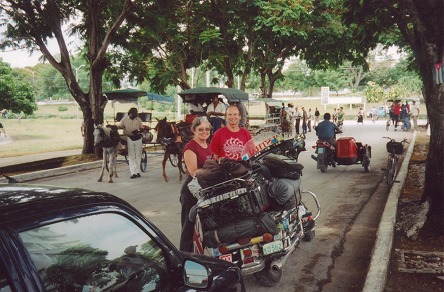
15/5/03 Transport is varied, most people walk long distances,
some go on horse drawn carts. Trucks are popular and can carry 100 people,
a few are privately owned and run, buses are irregular, private motorcycles
carry goods and the old American cars are usually privately owned, yellow
number plates. Government vehicles have blue and tourist vehicles, including
ours, red number plates, making it easy to identify, for us and the officials,
who is who. The only modern western cars are rentals, tour buses and security
vans, the rest are old Russian or American. Our 10 yr. old motorcycle is considered
new, and is, compared to local motorcycles. The concept of vehicles only
lasting 10 years in the west is inconceivable here. Petrol prices of $US
0.75 - 0.90c a litre keep traffic to a minimum. We rode to Gran Piedra, in
the mountains at 1250m and away from the coastal heat, in the morning.
In the evening we teamed up with a local for a few hours over a beer and
peso dinner, each firing questions about each other's country. Unfortunately
the concept here is that without Castro everything will be like the west.
They don't realize the turmoil of transition and that they will be giving
up job security, pensions and low crime rate for the benefits of freedom
of speech and mobility. If they follow the Russian path the times ahead will
be difficult. Later we watched a live band and western students dancing with
their local instructors till the early morning.
16/5/03 Where there is money corruption and crime starts.
The attendant at one museum had her scam to try and avoid giving out a ticket,
hopeful of pocketing the $US 1.00 entry fee and we heard reports that often
the dollars in the peso/dollar shops are skimmed off by management. This
in a country where we have not seen a rifle or hand gun carried by anyone.
Shop windows have no shutters or bars and are locked with a simple key, not
padlock. Corruption doesn't seem to have yet reached the police as we were
stopped for going through a pare (stop) sign, were talked to and let go.
Mostly we wandered the city, visited the "Carnival Museum" with its elaborate
costumes, talked to people, sat in parks and had an easy day.
17/5/03 Left the boat Monsoon for the last time. Jim couldn't
find a motorcycle to rent. Locals aren't allowed to rent their larger private
motorcycles and car rental places only have 50cc scooters, not suitable on
the open roads, instead he hired a small car for two weeks. Headed out to
Baracoa intending to visit the viewpoint overlooking Guantanamo Bay but it
seems the place has become more contentious lately and the road is blocked.
No possibility of viewing the Afghanis holidaying there at America's expense.
Santiago de Cuba was polluted by smoke stacks and old vehicles but the streets
were clean, people not littering and swept regularly. In the country the
air is clear and the roadside clean, there are few cars other than tourists,
few trucks and we enjoyed the traffic free ride along the beach and over
the mountain pass.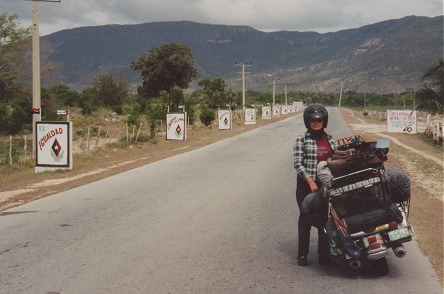
18/5/03 Casa Particulars are private houses that rent out
a couple of rooms to tourists. Part of the free market Castro allows. Heavily
taxed so they don't out compete government run hotels and banned in beachside
places where western style tourist hotels exist. For $US 15.00 a night you
get a room, aircon, hot shower, and use of a family's home. Some offer breakfast
and dinner. A great way to look inside one of the local's houses, not as
run down as they appear on the outside and a good way to meet locals. Friendly
and extremely competitive on price and features. We took a walk over the
gorge at Rio Yumuri and back down to the river for a swim. A guide for almost
nothing showed us the way, pointed out the uses of different plants and arranged
a boat out through the gorge. Not his usual job, freelancing, practising
English on his day off to supplement a $US 7.00 a month salary.
19/5/03 Headed out towards Moa on a secondary road reported
to be broken up old asphalt but after 40 km we were stopped by police, the
bridge ahead had collapsed, a month earlier. We would have to go the circuitous
route back through Guantanamo, and almost back to Santiago. To add to the
frustration the motorcycle's electrical system stopped charging and was fast
running down the battery. Back at the previous night's accommodation in Baracoa
we isolated the problem as the regulator. We have been carrying a spare one
for 7 years, you never know when you might need it. Hopefully we will get
further tomorrow.
20/5/03 Just passing through the country there is no evidence
of the current crackdown on dissidents however the rules governing tourists
and locals are different and changing. There are tourists only hotels and
as we discovered after our 400 km ride today, locals only hotels. Two hotels
out in the country that three years ago would accept both locals and foreigners
now only allow locals. There are separate home stay places for locals (a red
triangle on the door) and foreigners (blue). Men tourists are no longer allowed
to entertain local women in a bar, restaurant or hotel. While western dollars
are needed and wanted their spending clientele would preferably be isolated
in beachside resorts and not mingle and therefore influence the morals or
values of the locals. With only a couple of state run TV stations, news is
the government's view and at the moment the fear is an invasion from American
forces. It is normal locally to blame all of Cuba's problems on the US blockade
but with Afghanistan and Iraq captured, and Cuban officials recently expelled
from the US there is a genuine concern by Cubans of an invasion here. We
ended up in Holguin, after good roads, sugar cane country, and a long search
for accommodation. Again a peso dinner, two beers, chicken and salad, serenaded
by three musicians in a lively atmosphere, much more authentic than the stuffy
dollar restaurants and only $US 2.50 each.
21/5/03 Apparently the best paid job in the country is
bellhop at a tourist hotel. With monthly salary of less than $US 10.00 it
is the tips from satisfied westerners that add the cream. The sought after
job often requires the speaking of many languages, drivers license plus the
ability to solve westerners needs. We caught a bicycle taxi to the only internet
in town, three machines. Some bicycle taxi's have a license to carry foreigners,
others don't. We dodged police, taking back roads, obviously our taxi had
no license. As we slowly get closer to more touristy areas an increase in
wealth of locals is apparent. More local restaurants and bars, locals own
bicycles and houses are better looked after.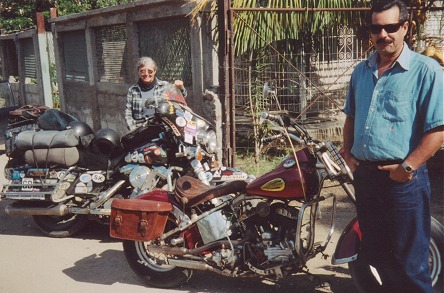
22/5/03 The first Harley-Davidson we have seen here was
parked on the roadside. A 1947 model. Parts in Cuba have been unavailable
since the 60's so any repairs have needed to be manufactured here, about half
the motorcycle. The tank, engine and frame about the only original pieces.
The tyres were bald but some extras, like the leather saddle bags, excellent
copies of the originals, logo's and all. 200 km to Camaguey with it's historical
centre. More modern cars but otherwise still in the 1950's movie set. Still
enjoying the local street foods and peso restaurants. Each town has local
variations as transport between is limited. Chocolate in mountain towns,
soy milk on the flats, sugar cane juice everywhere. A German bus tour group,
the first we have seen, staying in the one upmarket hotel.
23/5/03 The Cuban government recently announced the closure
of about half of the country's sugar mills and reduced production of cane
as it is costing more to produce than the price obtained on international
markets. This will affect about 400,000 workers, mostly in poorer rural areas,
such as we travelled through today, along the northern coastal flatlands.
In contrast they are building many new tourist hotels on Cayo Coco, part of
an enormous string of cays just off shore, connected by a 27 km long causeway
to the mainland built across the shallow waters in between.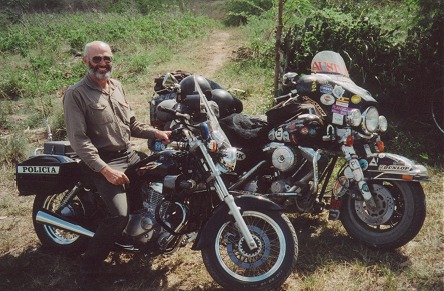 We travelled the causeway to the all inclusive segregated hotels where foreign
tourists don't often leave their hotels and rarely travel to the mainland
and where locals need special permission to travel to the Cays. Transport
options between towns are slow and limited for locals so Jim has been filling
his car with hitch-hikers, from whom we found out Carnival is on in Ciego
de Avila this weekend, where we are now headed.
We travelled the causeway to the all inclusive segregated hotels where foreign
tourists don't often leave their hotels and rarely travel to the mainland
and where locals need special permission to travel to the Cays. Transport
options between towns are slow and limited for locals so Jim has been filling
his car with hitch-hikers, from whom we found out Carnival is on in Ciego
de Avila this weekend, where we are now headed.
24/5/03 Unlike any other street celebrations we have seen.
Tens of thousands of people in their best clothes, of all ages, wander the
streets between venues strung out all over the city, lined with food and
beer stalls and ending with stages of disco music or live bands. They go
on for kilometres, three days, 24 hours a day. Most of the food was pork
based, pigs whole roasted, lying on benches, slowly cut up and sold in bread
rolls. Popcorn and deep fried banana chips. Ice cream and of course, beer.
Bring your own container, cup, plastic bottle to be refilled from one of
the dozens of mobile special built truck trailers.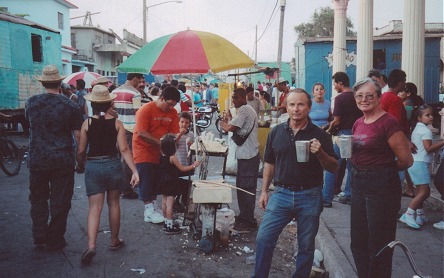 Refrigerated vats fill each truck dispensing beer at $US 0.20c a litre. A
rough estimate of your container's size and it's full to pass around amongst
your friends. In front of each stage young and old bopped to the music, moving
in that suggestive dance of Latin America spurred on by beer although hardly
necessary as they seem to be born with rhythm here and need no excuse to
dance. We wandered the throngs over the two evenings, trying all the foods
and truck beers but were in bed before most locals. There was a parade of
floats and dancing groups but these seemed less popular than the street wandering.
A true entertainment for the masses, where everyone joined in.
Refrigerated vats fill each truck dispensing beer at $US 0.20c a litre. A
rough estimate of your container's size and it's full to pass around amongst
your friends. In front of each stage young and old bopped to the music, moving
in that suggestive dance of Latin America spurred on by beer although hardly
necessary as they seem to be born with rhythm here and need no excuse to
dance. We wandered the throngs over the two evenings, trying all the foods
and truck beers but were in bed before most locals. There was a parade of
floats and dancing groups but these seemed less popular than the street wandering.
A true entertainment for the masses, where everyone joined in.
25/5/03 A short ride to Trinidad past an historical bridge
and a watch tower where from the top the workers used to be checked working
in the cane fields. By chance our casa particular's (homestay) owners in Trinidad
were celebrating their son's wedding this evening and we were invited along.
About 100 guests, two suckling pigs, a whole lamb and at great expense canned
quality beer. The short ceremony was in the house and had the usual western
trimmings of cake and dancing. As everything here, a lively event.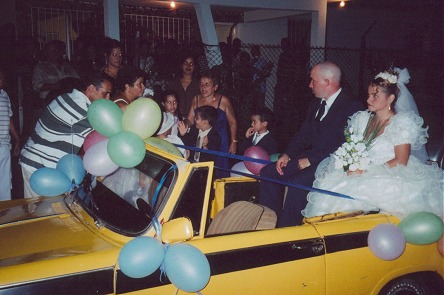 We were asked to take the motorcycle in the parade through the streets, bride
and groom sitting on the back of an old convertible Triumph motorcar, tooting
to the waving onlookers who were drawn from their homes. The bride and groom's
families are very well off by Cuban standards to be able to afford such an
event.
We were asked to take the motorcycle in the parade through the streets, bride
and groom sitting on the back of an old convertible Triumph motorcar, tooting
to the waving onlookers who were drawn from their homes. The bride and groom's
families are very well off by Cuban standards to be able to afford such an
event.
26/5/03 Trinidad is one of Cuba's historical cities remaining
almost untouched by new construction. This is helped by not being able to
buy or sell houses. Property owned can only be willed to close relatives on
the death of the owner, non home owners have to rent from the government.
No one is allowed to own more than one home, plus a small farm or holiday
house, other property is claimed by the state. Many of the city's buildings
are in need of restoration but its appeal still attracts a dozen or more tour
buses from Havana or resort towns each day but leaves the place to the relatively
few overnight tourists in the evening.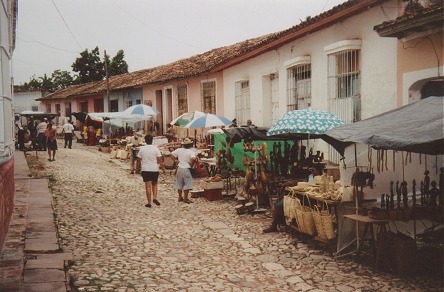
27/5/03 Wandered town, visited craft markets, were offered
illegal Cuban cigars, watched musical instruments being made in an open garage,
looked in on the chess club and listened to live music over a beer in the
evening.
28/5/03 It's been raining in town and on the surrounding
hills the last few days so today with clear skies we headed out to a small
river that flows out of the mouth of a cave. An hour's walk through forest
and some clambering over rocks up through the cave and gorge had us away from
town life.
29/5/03 There has been an electrical problem in the motorcycle
for some time. One of those intermittent problems you spend hours looking
for without success. The starter motor won't fire, the blinkers (flashers)
don't always work and the new regulator doesn't seem to be charging the battery
properly. At least today we isolated the start problem down to the ignition
switch and hopefully the others are related. It all meant riding through
the lovely countryside thinking of solutions rather than enjoying the ride.
We called in at Cienfuegos Marina to see if there were any boats heading
to North America, no, then onto Playa Giron to visit the Bay of Pigs Museum.
This CIA backed invasion of Cuba by exiled nationals in the early 1960's
is believed to have triggered the Cuban missile crisis, the closest the world
has been to all out nuclear war. Soundly defeated were the invaders and those
Cubans who died now martyrs. Seen locally as a victory against the imperialists
invaders.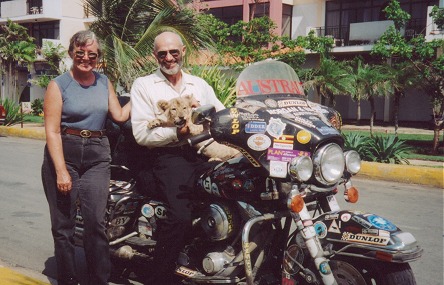
30/5/03 Rode straight to Havana, 6 lane rough built freeway
most of the way. People hitch hiking everywhere, looking for a lift as the
transport service between towns is sparse and traffic light, all buses full.
The section of Havana we are staying in is run down. It's reported that 300
buildings a year collapse here, and looking at them you can see why. Old
and poorly maintained, some with roofs collapsed and people living on the
lower floors. Like many big cities it is dirty, urine smells in the street
corners and the first time we have seen people sleeping on the street in
Cuba. The unit we rented is typical of the high-rise Soviet influence era.
Two bedroom, bath, living and kitchen, small and basic. It's on the sixth
floor but as only one lift works we have to walk to the second floor to catch
it, for some reason it won't stop on the sixth floor so we have to get out
on the seventh and walk down a flight.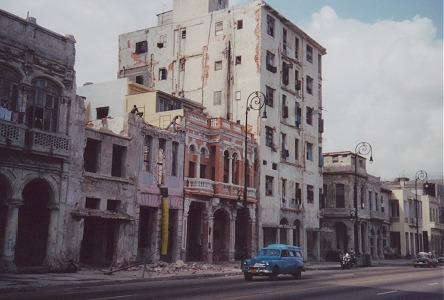 Whilst the unit is clean the community areas in the building smell of urine
and have dog faeces where the family pets couldn't make it to the street.
Our toilet doesn't flush, use a bucket of water, and the hot water shower
is a trickle, the aircon works as does the TV with it's two national programed
channels. The sounds of the neighbours dogs, children, arguments and TV's
emanate up the ventilation tubes as there are only wooden louvres as windows
and no glass. Jim is leaving in two days and we are thinking of ways to get
off the island. Hemmingway's Marina is an enormous complex of apartments along
canal developments fully serviced for yachts to come alongside the canal
edges. It can accommodate 400 boats, now housing about 60. Many belong to
Americans ignoring or circumventing the embargo, usually with Cuban girlfriends
or wives and living part of the year in each country. Many have motor bikes
to get around while in Cuba and transport them between countries without
problems. Unfortunately no boats big enough are leaving soon as most seem
to be long stay. Our preferred option is to get a boat from here direct to
Key West, just 140 km away, if possible.
Whilst the unit is clean the community areas in the building smell of urine
and have dog faeces where the family pets couldn't make it to the street.
Our toilet doesn't flush, use a bucket of water, and the hot water shower
is a trickle, the aircon works as does the TV with it's two national programed
channels. The sounds of the neighbours dogs, children, arguments and TV's
emanate up the ventilation tubes as there are only wooden louvres as windows
and no glass. Jim is leaving in two days and we are thinking of ways to get
off the island. Hemmingway's Marina is an enormous complex of apartments along
canal developments fully serviced for yachts to come alongside the canal
edges. It can accommodate 400 boats, now housing about 60. Many belong to
Americans ignoring or circumventing the embargo, usually with Cuban girlfriends
or wives and living part of the year in each country. Many have motor bikes
to get around while in Cuba and transport them between countries without
problems. Unfortunately no boats big enough are leaving soon as most seem
to be long stay. Our preferred option is to get a boat from here direct to
Key West, just 140 km away, if possible.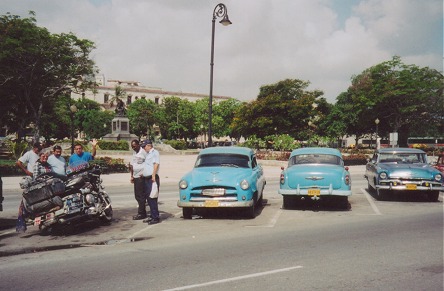
31/5/03 Less than 2 km's away from our accommodation is
the cruise ship terminal (forcibly closed due to no boats coming since 911
and pressure enforcing the embargo) and the renovated city. This is where
most fly in tourists are taken on their package holiday and it is truly magnificent.
Forts, churches, palaces dating back to the 1500's, cobbled streets radiating
out past other recently renovated buildings. Dozens of buildings are in various
stages of renovation expanding the old city tourist area. This in stark contrast
to the dilapidation nearby. The government's concentration on pushing tourism
unfortunately ostracizing many locals who are left out of the wealth growth
causing some bitterness. Back to Hemmingway's Marina to canvas more boats
about a lift to North America with reasonable success. A boat arrived today
and leaving in three days is seriously considering taking us, will know for
sure Monday, two days time.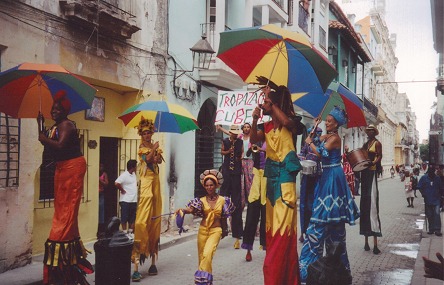
1/6/03 Jim flew home this morning, taking the long way
via the Dominican Republic as there are no direct flights to the USA from
Cuba. We returned to the old city meeting two teachers, polished in their
routine of welcoming tourists, we were shown to a couple of out of the way
local restaurants, talked English and asked many questions of the old and
new Cuba. On a salary of $US 13.00 a month each, we were happy to buy lunch,
two day's pay for them. In the evening a local bar, live band and music,
packed with dancers and lively. Cuba is a place where the government tries
to separate locals and tourists but where to feel the country you really
need to mix with the locals.
2/6/03 9.00 am the captain confirmed he was happy to take
us and the motorcycle to Key West, Florida. 10.00 am checked with authorities
what paperwork was required. $US 10.00 each to be put onto the crew list (departure tax). 11.00 am after
waiting in the bank line for 45 minutes had the $US 5.00 stamp necessary to
cancel the motorcycle registration and by 1.00 pm had the required paper from
the police after handing in the Cuban number plate. 2.00 pm had permission
from customs to load the motorcycle, necessary this afternoon as the tide
was right. 3.00 pm hunted around the marina for a loading ramp, borrowed from
the marina workshop. 4.00 pm washed the oil from the leaks and mud from road
grime of the motorcycle and by 5.00 pm had it on the boat's deck. 6.00 pm
it was tied down and covered. The five person crew invited us to dinner and
by 9.00 pm we were totally stuffed and caught a taxi back to our private
unit in Havana. The authorities in Cuba are problem solvers, not problem
makers, and whilst their cogs move slowly things that are logical can be
achieved readily. The 60 ft yacht we are leaving on tomorrow is a 40 yr old
wooden boat recently restored. Its five occupants are from different denomination
churches brought together by Christianity and a willingness to help less
fortunate people in different countries. They support an orphanage in Haiti
and bring bibles and religious materials to Cuba. The authorities here allow
religion but the import of materials is often taxed. Some items are overlooked
by customs, either well hidden or not considered necessary to be found, allowing
a token duty to be paid.
$US 10.00 each to be put onto the crew list (departure tax). 11.00 am after
waiting in the bank line for 45 minutes had the $US 5.00 stamp necessary to
cancel the motorcycle registration and by 1.00 pm had the required paper from
the police after handing in the Cuban number plate. 2.00 pm had permission
from customs to load the motorcycle, necessary this afternoon as the tide
was right. 3.00 pm hunted around the marina for a loading ramp, borrowed from
the marina workshop. 4.00 pm washed the oil from the leaks and mud from road
grime of the motorcycle and by 5.00 pm had it on the boat's deck. 6.00 pm
it was tied down and covered. The five person crew invited us to dinner and
by 9.00 pm we were totally stuffed and caught a taxi back to our private
unit in Havana. The authorities in Cuba are problem solvers, not problem
makers, and whilst their cogs move slowly things that are logical can be
achieved readily. The 60 ft yacht we are leaving on tomorrow is a 40 yr old
wooden boat recently restored. Its five occupants are from different denomination
churches brought together by Christianity and a willingness to help less
fortunate people in different countries. They support an orphanage in Haiti
and bring bibles and religious materials to Cuba. The authorities here allow
religion but the import of materials is often taxed. Some items are overlooked
by customs, either well hidden or not considered necessary to be found, allowing
a token duty to be paid.
3/6/03 Returned to the boat and with the Captain arranging
paperwork for departure we had interesting discussions with the remaining
crew. The only female member had slipped on a set of stairs whilst carrying some
mission goods, her ankle being plaster cast and her mobility on the boat restricted.
A professional photographer, about to exhibit his works in Key West, based
on some of the unusual aspects of Cuba, caught in its 50's time warp. A motorcycle
restorer come carpenter come cook capable of turning a hand to anything including
mission work. We left by 3 pm without paperwork problems and headed into
a calm sea and no wind which soon became choppy and rolly in the light boat.
The only female member had slipped on a set of stairs whilst carrying some
mission goods, her ankle being plaster cast and her mobility on the boat restricted.
A professional photographer, about to exhibit his works in Key West, based
on some of the unusual aspects of Cuba, caught in its 50's time warp. A motorcycle
restorer come carpenter come cook capable of turning a hand to anything including
mission work. We left by 3 pm without paperwork problems and headed into
a calm sea and no wind which soon became choppy and rolly in the light boat.
4/6/03 By our watch at midnight Kay and I were feeling
unwell, the sails were up with the wind and swell against the Gulf stream
current causing an uncomfortable lumpy sea. We had both fed the fish before
our shift ended at 4 am.
Move with us to United States
of America
 11/5/03 We started radioing the authorities at the 12 mile
limit but there was no response till only a few miles offshore when we were
advised to anchor in the bay. Santiago de Cuba has a magnificent harbour
entry to a country, an old castle on one headland and small boats ferrying
people across to islands and peninsulas, opening up into a large bay. Being
Sunday it took the authorities an hour to muster before we could come alongside
the marina, with quarantine the first 40 minutes and when cleared of diseases
a team of seven officials boarded. A few customs officials politely and efficiently
searched for over an hour, insisting that we watch to ensure no petty theft.
Agricultural inspectors checked food, looking for weevils mainly, and immigration
issued us with a tourist card ($US 15.00) valid for 30 days, using the boat
as our hotel booking, and yet we were free to leave the boat, travel independently,
and no onward ticket was asked for. We were now independent of the boat.
The motorcycle could be landed, and was, the tyres had to be washed in case
of diseases, and its import could be attached to our passports and not the
boat, thus also independent of the boat. Paperwork however for the motorcycle
would have to be done tomorrow, a working day. This whole process took till
2 pm, was polite, efficient and thorough. Drinks were offered, and accepted,
Coca Cola was not as favoured as the rum, where over a litre was consumed,
the officers leaving when the last of the bottle was consumed. The marina
manager offered us a welcome drink at the bar in the evening and we watched
dancing and partying at another pier out over the water. A great welcoming
and a relief to be able to move independently of the boat in Cuba.
11/5/03 We started radioing the authorities at the 12 mile
limit but there was no response till only a few miles offshore when we were
advised to anchor in the bay. Santiago de Cuba has a magnificent harbour
entry to a country, an old castle on one headland and small boats ferrying
people across to islands and peninsulas, opening up into a large bay. Being
Sunday it took the authorities an hour to muster before we could come alongside
the marina, with quarantine the first 40 minutes and when cleared of diseases
a team of seven officials boarded. A few customs officials politely and efficiently
searched for over an hour, insisting that we watch to ensure no petty theft.
Agricultural inspectors checked food, looking for weevils mainly, and immigration
issued us with a tourist card ($US 15.00) valid for 30 days, using the boat
as our hotel booking, and yet we were free to leave the boat, travel independently,
and no onward ticket was asked for. We were now independent of the boat.
The motorcycle could be landed, and was, the tyres had to be washed in case
of diseases, and its import could be attached to our passports and not the
boat, thus also independent of the boat. Paperwork however for the motorcycle
would have to be done tomorrow, a working day. This whole process took till
2 pm, was polite, efficient and thorough. Drinks were offered, and accepted,
Coca Cola was not as favoured as the rum, where over a litre was consumed,
the officers leaving when the last of the bottle was consumed. The marina
manager offered us a welcome drink at the bar in the evening and we watched
dancing and partying at another pier out over the water. A great welcoming
and a relief to be able to move independently of the boat in Cuba.




 We travelled the causeway to the all inclusive segregated hotels where foreign
tourists don't often leave their hotels and rarely travel to the mainland
and where locals need special permission to travel to the Cays. Transport
options between towns are slow and limited for locals so Jim has been filling
his car with hitch-hikers, from whom we found out Carnival is on in Ciego
de Avila this weekend, where we are now headed.
We travelled the causeway to the all inclusive segregated hotels where foreign
tourists don't often leave their hotels and rarely travel to the mainland
and where locals need special permission to travel to the Cays. Transport
options between towns are slow and limited for locals so Jim has been filling
his car with hitch-hikers, from whom we found out Carnival is on in Ciego
de Avila this weekend, where we are now headed.  Refrigerated vats fill each truck dispensing beer at $US 0.20c a litre. A
rough estimate of your container's size and it's full to pass around amongst
your friends. In front of each stage young and old bopped to the music, moving
in that suggestive dance of Latin America spurred on by beer although hardly
necessary as they seem to be born with rhythm here and need no excuse to
dance. We wandered the throngs over the two evenings, trying all the foods
and truck beers but were in bed before most locals. There was a parade of
floats and dancing groups but these seemed less popular than the street wandering.
A true entertainment for the masses, where everyone joined in.
Refrigerated vats fill each truck dispensing beer at $US 0.20c a litre. A
rough estimate of your container's size and it's full to pass around amongst
your friends. In front of each stage young and old bopped to the music, moving
in that suggestive dance of Latin America spurred on by beer although hardly
necessary as they seem to be born with rhythm here and need no excuse to
dance. We wandered the throngs over the two evenings, trying all the foods
and truck beers but were in bed before most locals. There was a parade of
floats and dancing groups but these seemed less popular than the street wandering.
A true entertainment for the masses, where everyone joined in.  We were asked to take the motorcycle in the parade through the streets, bride
and groom sitting on the back of an old convertible Triumph motorcar, tooting
to the waving onlookers who were drawn from their homes. The bride and groom's
families are very well off by Cuban standards to be able to afford such an
event.
We were asked to take the motorcycle in the parade through the streets, bride
and groom sitting on the back of an old convertible Triumph motorcar, tooting
to the waving onlookers who were drawn from their homes. The bride and groom's
families are very well off by Cuban standards to be able to afford such an
event. 

 Whilst the unit is clean the community areas in the building smell of urine
and have dog faeces where the family pets couldn't make it to the street.
Our toilet doesn't flush, use a bucket of water, and the hot water shower
is a trickle, the aircon works as does the TV with it's two national programed
channels. The sounds of the neighbours dogs, children, arguments and TV's
emanate up the ventilation tubes as there are only wooden louvres as windows
and no glass. Jim is leaving in two days and we are thinking of ways to get
off the island. Hemmingway's Marina is an enormous complex of apartments along
canal developments fully serviced for yachts to come alongside the canal
edges. It can accommodate 400 boats, now housing about 60. Many belong to
Americans ignoring or circumventing the embargo, usually with Cuban girlfriends
or wives and living part of the year in each country. Many have motor bikes
to get around while in Cuba and transport them between countries without
problems. Unfortunately no boats big enough are leaving soon as most seem
to be long stay. Our preferred option is to get a boat from here direct to
Key West, just 140 km away, if possible.
Whilst the unit is clean the community areas in the building smell of urine
and have dog faeces where the family pets couldn't make it to the street.
Our toilet doesn't flush, use a bucket of water, and the hot water shower
is a trickle, the aircon works as does the TV with it's two national programed
channels. The sounds of the neighbours dogs, children, arguments and TV's
emanate up the ventilation tubes as there are only wooden louvres as windows
and no glass. Jim is leaving in two days and we are thinking of ways to get
off the island. Hemmingway's Marina is an enormous complex of apartments along
canal developments fully serviced for yachts to come alongside the canal
edges. It can accommodate 400 boats, now housing about 60. Many belong to
Americans ignoring or circumventing the embargo, usually with Cuban girlfriends
or wives and living part of the year in each country. Many have motor bikes
to get around while in Cuba and transport them between countries without
problems. Unfortunately no boats big enough are leaving soon as most seem
to be long stay. Our preferred option is to get a boat from here direct to
Key West, just 140 km away, if possible.

 $US 10.00 each to be put onto the crew list (departure tax). 11.00 am after
waiting in the bank line for 45 minutes had the $US 5.00 stamp necessary to
cancel the motorcycle registration and by 1.00 pm had the required paper from
the police after handing in the Cuban number plate. 2.00 pm had permission
from customs to load the motorcycle, necessary this afternoon as the tide
was right. 3.00 pm hunted around the marina for a loading ramp, borrowed from
the marina workshop. 4.00 pm washed the oil from the leaks and mud from road
grime of the motorcycle and by 5.00 pm had it on the boat's deck. 6.00 pm
it was tied down and covered. The five person crew invited us to dinner and
by 9.00 pm we were totally stuffed and caught a taxi back to our private
unit in Havana. The authorities in Cuba are problem solvers, not problem
makers, and whilst their cogs move slowly things that are logical can be
achieved readily. The 60 ft yacht we are leaving on tomorrow is a 40 yr old
wooden boat recently restored. Its five occupants are from different denomination
churches brought together by Christianity and a willingness to help less
fortunate people in different countries. They support an orphanage in Haiti
and bring bibles and religious materials to Cuba. The authorities here allow
religion but the import of materials is often taxed. Some items are overlooked
by customs, either well hidden or not considered necessary to be found, allowing
a token duty to be paid.
$US 10.00 each to be put onto the crew list (departure tax). 11.00 am after
waiting in the bank line for 45 minutes had the $US 5.00 stamp necessary to
cancel the motorcycle registration and by 1.00 pm had the required paper from
the police after handing in the Cuban number plate. 2.00 pm had permission
from customs to load the motorcycle, necessary this afternoon as the tide
was right. 3.00 pm hunted around the marina for a loading ramp, borrowed from
the marina workshop. 4.00 pm washed the oil from the leaks and mud from road
grime of the motorcycle and by 5.00 pm had it on the boat's deck. 6.00 pm
it was tied down and covered. The five person crew invited us to dinner and
by 9.00 pm we were totally stuffed and caught a taxi back to our private
unit in Havana. The authorities in Cuba are problem solvers, not problem
makers, and whilst their cogs move slowly things that are logical can be
achieved readily. The 60 ft yacht we are leaving on tomorrow is a 40 yr old
wooden boat recently restored. Its five occupants are from different denomination
churches brought together by Christianity and a willingness to help less
fortunate people in different countries. They support an orphanage in Haiti
and bring bibles and religious materials to Cuba. The authorities here allow
religion but the import of materials is often taxed. Some items are overlooked
by customs, either well hidden or not considered necessary to be found, allowing
a token duty to be paid.  The only female member had slipped on a set of stairs whilst carrying some
mission goods, her ankle being plaster cast and her mobility on the boat restricted.
A professional photographer, about to exhibit his works in Key West, based
on some of the unusual aspects of Cuba, caught in its 50's time warp. A motorcycle
restorer come carpenter come cook capable of turning a hand to anything including
mission work. We left by 3 pm without paperwork problems and headed into
a calm sea and no wind which soon became choppy and rolly in the light boat.
The only female member had slipped on a set of stairs whilst carrying some
mission goods, her ankle being plaster cast and her mobility on the boat restricted.
A professional photographer, about to exhibit his works in Key West, based
on some of the unusual aspects of Cuba, caught in its 50's time warp. A motorcycle
restorer come carpenter come cook capable of turning a hand to anything including
mission work. We left by 3 pm without paperwork problems and headed into
a calm sea and no wind which soon became choppy and rolly in the light boat.